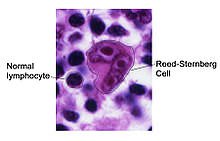Hodgkin-Lymphom und Non-Hodgkin-Lymphom sind Arten von Blutkrebs , die ihren Ursprung in Lymphozyten oder weißen Blutkörperchen haben . Die überwiegende Mehrheit (90%) der Lymphome sind Non-Hodgkin. Die Hodgkin-Krankheit war die erste Form des Lymphoms, die 1832 beschrieben und definiert wurde. Sie betrifft normalerweise junge Erwachsene und hat eine 5-Jahres-Überlebensrate von etwa 84%. Beim Non-Hodgkin-Lymphom (NHL) hängt die Prognose davon ab, um welche der 16 NHL-Typen es sich handelt. Sie reichen von aggressiv bis träge und die Behandlungsmethoden und die Überlebensrate variieren entsprechend.
Contents
Vergleichstabelle
| Hodgkin’s Lymphoma | Non-Hodgkin’s Lymphoma | |
|---|---|---|
| Introduction (from Wikipedia) | Hodgkin’s lymphoma, also known as Hodgkin lymphoma and previously known as Hodgkin’s disease, is a type of lymphoma, which is a cancer originating from white blood cells called lymphocytes. | The non-Hodgkin lymphomas are diverse group of blood cancers that include any kind of lymphoma except Hodgkin’s lymphomas. Types of NHL vary significantly in their severity, from indolent to very aggressive. |
| Symptoms | Typically asymptomatic. Swollen lymph nodes, weight loss, fevers, night sweats in advanced stages of the disease. | Swollen lymph nodes, weight loss, fevers, night sweats are common symptoms for NHL also. Different types of NHL have different symptoms. |
| Cell involved | Reed-Sternberg Cell | Various, but NOT Reed-Sternberg |
| Occurrence | 1% of all cancers | 5th or 6th most common cancer in the US |
| Occurs mostly in | Young people, particularly age 20-30 | People over 60 |
| Treatment | Surgery, radiotherapy, chemotherapy, hematopoietic stem cell transplantation | Radiotherapy, chemotherapy, hematopoietic stem cell transplantation |
| Prognosis | A 10-year survival rate of over 80% | Varies |

A blood cancer-awareness advertisement at a bus stop
What is lymphoma?
Lymphoma is a type of blood cancer. When white blood cells start to behave abnormally — for example, live longer or divide faster than normal cells — they form tumors. As tumors grow, they deprive surrounding tissues and organs of oxygen and nutrients. Lymphoma may start in the lymph nodes, spleen, bone marrow, blood or other organs and spread from its origin depending upon how aggressive the disease is.

A Reed-Sternberg cell is characteristic of Hodgkin’s lymphoma.
What is Hodgkin’s lymphoma?
Hodgkin’s lymphoma, also called Hodgkin’s disease, is a special type of lymphoma that involves the Reed–Sternberg cells, which are giant cells formed by the fusion of several different cells and therefore contain multiple nuclei. Hodgkin’s is characterized by the orderly spread of disease from one lymph node group to another. It is generally asymptomatic and has good prognosis unless the disease is advanced. B symptoms — systemic symptoms of fever, night sweats and weight loss — develop with advanced disease. Hodgkin’s lymphoma tends to be confined to one lymph node in the body and spreads through the body through the bloodstream, while non-Hodgkin’s can occur in many different lymph nodes. Hodgkin lymphoma is much more radiation-sensitive than most other forms of lymphoma.
<iframe width=”450″ height=”253″ frameborder=”0″ allowfullscreen src=”https://www.youtube.com/embed/4tlCkxa_Kdc?iv_load_policy=3&rel=0&start=8″></iframe>
What is non-Hodgkin lymphoma?
All types of lymphoma other than Hodgkin’s are categorized under non-Hodgkin lymphoma (NHL). There are 16 types of NHL and they are quite different from each other.
<iframe width=”450″ height=”253″ frameborder=”0″ allowfullscreen src=”https://www.youtube.com/embed/NV1CSvO_XaA?iv_load_policy=3&rel=0″></iframe>
Other classifications for lymphoma
Since types of NHL are all very different from one another, Hodgkin’s vs non-Hodgkin’s is not a particularly useful classification. The WHO classification, based on the Revised European-American Lymphoma (REAL) classification, attempts to group lymphomas by cell type into three large groups: B cell, T cell, and natural killer cell tumors.
Symptoms
Both types of lymphoma involve painless swelling of lymph nodes. Hodgkin’s lymphoma is more likely to have swelling lymph nodes in the upper body, such as the chest, underarms or necks, but both types can occur anywhere in the body. They both also include symptoms such as weight loss, fevers and night sweats when the disease progresses to an advanced stage.
Occurrence
Non-Hodgkin’s is more common than Hodgkin’s, and is the sixth-most common cancer in men and fifth most common cancer in women in the United States . Hodgkin’s only accounts for about 1% of all cancer in the U.S. and has been declining in recent years.
The risk of non-Hodgkin’s increases with age, with most patients in their 60s. Hodgkin’s occurs most commonly in people between 15 and 40 years of age (most commonly in people age 20-30) and in people who are 55 or older.
Diagnosis
The exact type of lymphoma must be diagnosed to ensure the right treatment. This can include blood tests, biopsies of bone marrow, and chest x-rays. The definitive test includes the biopsy of part or all of an affected lymph node. Hodgkin’s involves the presence of a Reed-Sternberg cell, while there are over 30 different types of non-Hodgkin’s.
Treatment
Prognosis and treatment depends on the exact type of the lymphocytes, the characteristics and location of the tumor, and the extent to which it has already grown. According to the American Cancer Society, the 5 year survival rate for Hodgkin’s is 85%, with a 10 year survival rate of 81%. There are many different forms of non-Hodgkin’s, and prognoses vary, but Hodgkin’s tends to be easier to treat, as it is focused in one lymph node. Radiation and chemotherapy are used for both types, but chemotherapy is the primary treatment option for non-Hodgkin’s, along with anti-CD20 monoclonal antibodies or hematopoietic stem cell transplantation. Hodgkin’s may be treated by surgery or hematopoietic stem cell transplantation.
References
- wikipedia:Lymphoma
- wikipedia:Hodgkin’s lymphoma
- Wikipedia: Non-Hodgkin-Lymphom
- Lymphom – MedlinePlus
- Non-Hodkin-Lymphom – Mayo-Klinik